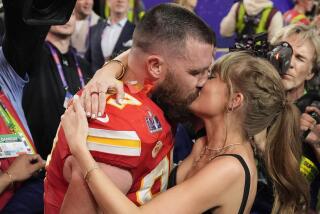COMMENTARY : A Super Bowlful of Hype Over the Cola Confrontation : Television: In all, there were 59 commercials in a nearly four-hour telecast.
- Share via
The Super Bowl came blasting on Sunday with words like “greatness,” “monumental achievements,” “grit and determination,” “prodigious talents,” “ultimate confrontation.”
Silly us, we thought they were talking about the teams.
Obviously the game wasn’t very monumental. They probably were referring to the ultimate confrontation between Coca-Cola and Pepsi-Cola.
The final score isn’t known, since this is a continuing contest . . . although Joe Montana came up on the Diet Pepsi side in an introductory commercial, challenging Diet Coke drinkers to a taste-off.
In all, in this annual paean to American free enterprise, we saw 59 commercials--15, 30 or 60 seconds long--during the nearly four-hour show. They accounted for nearly 50 minutes of super salesmanship.
The base price per national 30 seconds was $700,000, with the estimated CBS take at $60 million. (The network also employed 36 promos for its own shows.)
The most prevalent advertiser (six spots, reportedly $7 million worth) was Bud Light and Budweiser in “Bud Bowl II,” a sequel to last year’s battling beer bottles, which someone somewhere must have thought amusing.
There were some neat spots, among them the American Express non-message that showed mean machine Paul Newman speeding off on a mite-sized motor scooter.
In what supposedly is the slickest of Super Bowl spots, if not the safest, the Nissan sporty Turbo Z outzips speed cycles, formula race cars and fighter jets. It was superdirected by Ridley Scott (as in “Blade Runner” and “Black Rain”).
AT&T; was there to proclaim itself “dependable,” without any reference to certain undependable computers of recent days.
But the good fight was there in the multitudinous commercials for Coke and Pepsi products (with Coke getting an edge with the help of McDonald’s, with which it has an exclusive contract, so that Diet Coke showed prominently in McDonald’s spots).
Chris Evert said she had had enough of Diet Pepsi and gave up in favor of Diet Coke. (In Joe Montana’s spot, he challenged “Miss Wimbledon” to switch again.) Sugar Ray Leonard trained on Diet Coke and punched out Diet Pepsi. Paula Abdul and Elton John kicked up their heels for Diet Coke. Michael J. Fox got locked out of the opera but finally found a Diet Pepsi and sat down to enjoy it--only to find himself raised onto the stage. Fred Savage, inspired by his sparkling Pepsi, wrote a love letter to his bubbly, effervescent girlfriend. It made her feel . . . like a Pepsi.
Coke, of course, took the world view by reassembling some of the same singers and some of their children from its 1971 “Hilltop” commercial. About 400 people, each with a Classic Coke in hand, resang the mushy “I’d Like to Buy the World a Coke.”
It’s hard to figure who won, if indeed any of this is good for you and anybody wins at all. But if the advertising philosophy holds that celebrity is everything, then Joe Montana knows as much about soft drinks as he knows about the Denver defense.
Then we surmise that in the 49ers’ lockerroom, they were toasting victory with properly chilled Diet Pepsi. The Broncos were drinking Diet Coke. And gagging on it.
More to Read
Go beyond the scoreboard
Get the latest on L.A.'s teams in the daily Sports Report newsletter.
You may occasionally receive promotional content from the Los Angeles Times.










